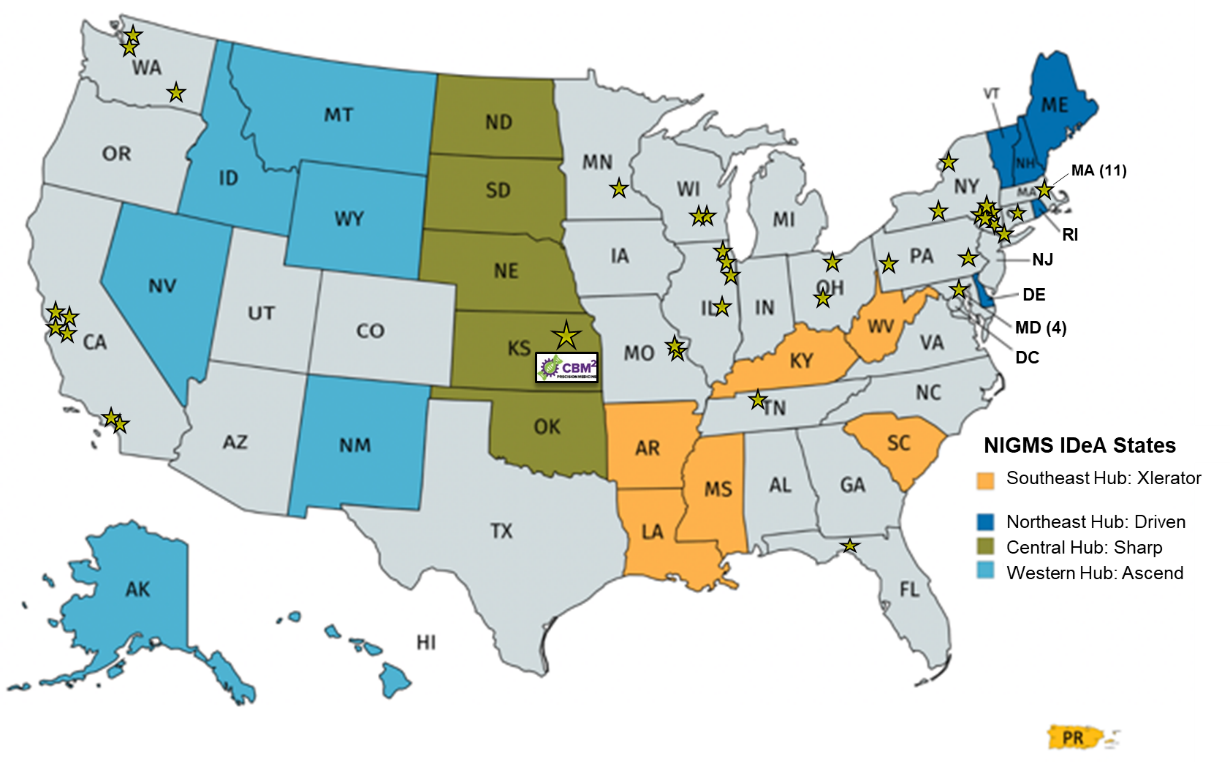CBM2 Renewed
CBM2 was recently renewed for funding through the National Institutes of Health, NIH (National Institute of Biomedical Imaging and Bioengineering; NIBIB; $6.0M over 5 years) as a National Biotechnology Resource Center (P41 Center).
There are 50 P41 Centers within the United States and all of them are funded by the NIH. Unique to CBM2 is that it is the only P41 Center within an NIH IDeA (Institutional Development Awards) state (see map below). The IDeA program’s goal (congressionally mandeted in 1993) is to broaden the geographic distribution of NIH funding in states that have traditionally received low levels of NIH funding. P41 Centers provide innovative technologies that can be disseminated into the biomedical community to ehance the research capabilities of NIH grantees, even those in IDeA states. The Director of the Center is Prof. Steven A. Soper (Foundation Distinguished Professor, Chemistry and Mechanical Engineer) at the University of Kansas (KU).
CBM2 was originally funded in 2015 while Prof. Soper was at the University of North Carolina, Chapel Hill and was moved to KU in 2016 when Soper accepted a position at KU. In September 2021, CBM2 was successfully renewed for another 5 years of operation after a rigorous review process by the NIH. CBM2 partners include the University of Kansas Medical Center, KUMC (Dr. Andrew Godwin, Co-Director), University of North Carolina, Chapel Hill (Dr. David Kaufman, Co-Director), Louisiana State University (Profs. Sunggook Park and Michael C. Murphy), and Wake Forest School of Medicine (Prof. Adam Hall).
CBM2 is developing micro- and nanotechnologies (lab-on-a-chip, LOC; see picture to the right) that are made from plastics via injection molding, the same production tools used for producing CDs, DVDs, and blue-ray disks. These unique LOCs are being used for the analysis of circulating markers or the so-called liquid biopsy markers that are secured from a simple blood draw or other bodily fluids. The liquid biopsy markers include circulating tumor cells, cell-free DNA, and nanoscale particles such as virus particle, and vesicles, which are released by biological cells associated with a particular disease.
CBM2 collaborates with clinicians across the country to evaluate the use of its technology outputs in different diseases. The Center is working with Prof. Alison Baird (SUNY Downstate Medical Center, New York, NY) on a test, which uses small vesicles as a source of markers for stroke (point-of-care test for diagnosing ischemic stroke). The test can be completed in ~30 min to help decide how to treat patients with stroke effectively (currently less than 4% of stroke patients receive proper therapy). As another example, the Center is developing a new nanotechnology platform for the sequencing of RNA and DNA; this will be important in determining changes associated with the RNA genome of viruses that give rise to variants, such as those associated with COVID-19. The Center is also building a handheld instrument that can be used to detect those infected with viruses giving rise to COVID-19 or to detect ovarian cancer early in women with a high family risk (joint studies with Godwin at KUMC).
CBM2 has a number of commerical partners seeking to move Center discoveries into the marketplace. For example, one partner is BioFluidica, Inc. (San Diego, CA), which has developed instruments for the isolation and analysis of liquid biopsy markers. There are several of these instruments already in place at the KU Cancer Center (Dr. Roy Jensen, Director) that are being used to develop diagnostic biomarkers to improve the outcomes of cancer patients in our region as well as those across the U.S. For example, the Center is working with Dr. Anup Kasi (KUMC) on clinical trials evaluating new therapeutics for pancreatic cancer, which accounts for 7% of all cancer deaths across the U.S. with a 5 year survival rate <5%. CBM2 is using circulating tumor cells as an indicator of response to therapy. The circulating tumor cells are secured from a blood sample using a plastic microchip pioneered by the Center. CBM2 also works with the Kansas Institute for Precision Medicine, which his an NIH COBRE effort (Godwin, Director; Soper, co-Director; COBRE – Center of Biomedical Research Excellence) by generating micro-technologies to support their junor faculty developing new lines of research that can improve patient outcomes.
To train the next generation of scientists well versed in multidisciplinary research, the Center offers an extensive training program for K-16 students and the general public. This program is being managed by Dr. Małgorzata A. Witek (KU). Training efforts include teaching students to appreciate concepts such as precision medicine, and sense-of-scale as well as the valuable contributions engineers provide to medicine. Dr. Witek and her team reach >1,000 students annually. The Center is also working with Sharp Hub IDeA states (see map below) to share its experiences in creating infrastructure to improve research competitiveness nationally in these states.
